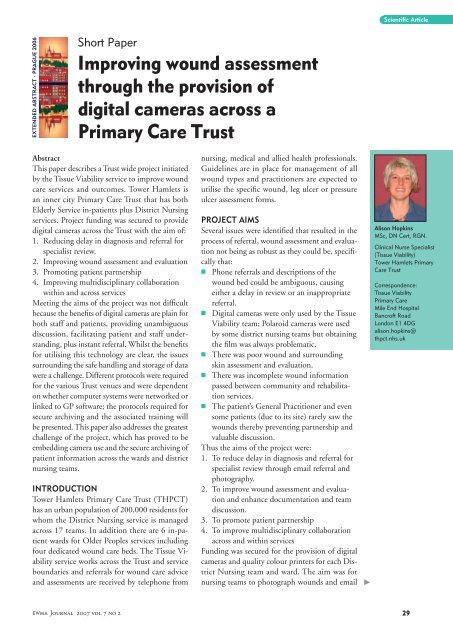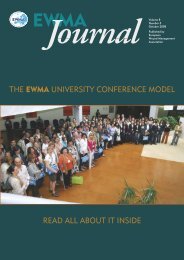You also want an ePaper? Increase the reach of your titles
YUMPU automatically turns print PDFs into web optimized ePapers that Google loves.
EXTENDED ABSTRACT · PRAGUE 2006<br />
Short Paper<br />
Improving wound assessment<br />
through the provision of<br />
digital cameras across a<br />
Primary Care Trust<br />
Abstract<br />
This paper describes a Trust wide project initiated<br />
by the Tissue Viability service to improve wound<br />
care services and outcomes. Tower Hamlets is<br />
an inner city Primary Care Trust that has both<br />
Elderly Service in-patients plus District Nursing<br />
services. Project funding was secured to provide<br />
digital cameras across the Trust with the aim of:<br />
1. Reducing delay in diagnosis and referral for<br />
specialist review.<br />
2. Improving wound assessment and evaluation<br />
3. Promoting patient partnership<br />
4. Improving multidisciplinary collaboration<br />
within and across services<br />
Meeting the aims of the project was not difficult<br />
because the benefits of digital cameras are plain for<br />
both staff and patients, providing unambiguous<br />
discussion, facilitating patient and staff understanding,<br />
plus instant referral. Whilst the benefits<br />
for utilising this technology are clear, the issues<br />
surrounding the safe handling and storage of data<br />
were a challenge. Different protocols were required<br />
for the various Trust venues and were dependent<br />
on whether computer systems were networked or<br />
linked to GP software; the protocols required for<br />
secure archiving and the associated training will<br />
be presented. This paper also addresses the greatest<br />
challenge of the project, which has proved to be<br />
embedding camera use and the secure archiving of<br />
patient information across the wards and district<br />
nursing teams.<br />
INTRODUCTION<br />
Tower Hamlets Primary Care Trust (THPCT)<br />
has an urban population of 200,000 residents for<br />
whom the District Nursing service is managed<br />
across 17 teams. In addition there are 6 in-patient<br />
wards for Older Peoples services including<br />
four dedicated wound care beds. The Tissue Viability<br />
service works across the Trust and service<br />
boundaries and referrals for wound care advice<br />
and assessments are received by telephone from<br />
<strong>EWMA</strong> Journal 2007 vol 7 no 2<br />
nursing, medical and allied health professionals.<br />
Guidelines are in place for management of all<br />
wound types and practitioners are expected to<br />
utilise the specific wound, leg ulcer or pressure<br />
ulcer assessment forms.<br />
PROJECT AIMS<br />
Several issues were identified that resulted in the<br />
process of referral, wound assessment and evaluation<br />
not being as robust as they could be, specifically<br />
that:<br />
n Phone referrals and descriptions of the<br />
wound bed could be ambiguous, causing<br />
either a delay in review or an inappropriate<br />
referral.<br />
n Digital cameras were only used by the Tissue<br />
Viability team; Polaroid cameras were used<br />
by some district nursing teams but obtaining<br />
the film was always problematic.<br />
n There was poor wound and surrounding<br />
skin assessment and evaluation.<br />
n There was incomplete wound information<br />
passed between community and rehabilitation<br />
services.<br />
n The patient’s General Practitioner and even<br />
some patients (due to its site) rarely saw the<br />
wounds thereby preventing partnership and<br />
valuable discussion.<br />
Thus the aims of the project were:<br />
1. To reduce delay in diagnosis and referral for<br />
specialist review through email referral and<br />
photography.<br />
2. To improve wound assessment and evaluation<br />
and enhance documentation and team<br />
discussion.<br />
3. To promote patient partnership<br />
4. To improve multidisciplinary collaboration<br />
across and within services<br />
Funding was secured for the provision of digital<br />
cameras and quality colour printers for each District<br />
Nursing team and ward. The aim was for<br />
nursing teams to photograph wounds and email<br />
�<br />
Scientific Article<br />
Alison Hopkins<br />
MSc, DN Cert, RGN.<br />
Clinical Nurse Specialist<br />
(Tissue Viability)<br />
Tower Hamlets Primary<br />
Care Trust<br />
Correspondence:<br />
Tissue Viability<br />
Primary Care<br />
Mile End Hospital<br />
Bancroft Road<br />
London E1 4DG<br />
alison.hopkins@<br />
thpct.nhs.uk

















